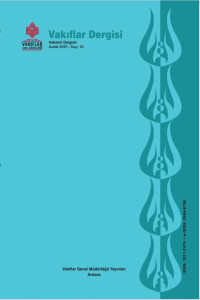Abstract
Sultan I. Mahmud döneminde (1730-1754), Bahçeköy’de Taksim’e getirilen suyun bağlanmasıyla on sekizinci yüzyıl ortalarından itibaren İstanbul’un nüfusu artan yerleşimlerinden biri haline gelen Beşiktaş’ta semtin düzenli bir su sistemine sahip olmasını izleyen süreçte çeşme ve hamam sayısında ciddi bir artış gözlemlenmektedir. Düzenli su temininin sağlanmasının ardından Beşiktaş’ta inşa edilen hamamlardan biri Ihlamurdere Caddesi üzerinde yer alan Küçük Hamam ya da diğer adıyla Köyiçi Hamamı’dır. Bu çalışma, on dokuzuncu yüzyılın ilk yarısına tarihlenen ve Beşiktaş semtinde günümüze ulaşan tek Osmanlı hamam yapısı durumundaki Küçük Hamam’ı (Köyiçi Hamamı) mevcut durumu üzerinden değerlendirmeyi amaçlamaktadır.
Keywords
References
- Akbayar, Nuri (ed.) (1998). Dünden Bugüne Beşiktaş. İstanbul: Beşiktaş Belediye Başkanlığı.
- Ayvansarayî Hüseyin Efendi, Ali Satı Efendi, Süleyman Besim Efendi (2001). Hadikatü'l-Cevâmiʻ / İstanbul Camileri ve Diğer Dini-Sivil Mimari Yapılar. İstanbul: İşaret Yayınları.
- Çeçen, Kazım (1992). Taksim ve Hamidiye Suları. İstanbul: İSKİ Yayınları.
- Ergin, Osman Nuri (1995). Mecelle-i Umûr-ı Belediyye, 7. İstanbul: İstanbul Büyükşehir Belediyesi Kültür İşleri Daire Başkanlıǧı.
- Evliyâ Çelebi b. Derviş Mehmed Zıllî (2006). Evliyâ Çelebi Seyahatnamesi I. Kitap,Topkapı Sarayı Kütüphanesi Bağdat 304 Numaralı Yazmanın Transkripsiyonu – Dizini. haz. Robert Dankoff vd. İstanbul: Yapı Kredi Yayınları.
- Eyice, Semavi (1960). “İznik’de Büyük Hamam ve Osmanlı Devri Hamamları Üzerine Bir Deneme”. İstanbul Üniversitesi Edebiyat Fakültesi Dergisi, XI (15), 99-120.
- Eyice, Semavi (1997). “Hamam”. Türkiye Diyanet Vakfı İslam Ansiklopedisi, C. 15, 402-430.
- Gökyay, Demet (2009). Beşiktaş Köyiçi Kentsel Sit Alanının 20. yy. Başından Günümüze Değişimi ve Korunması için Öneriler. Yüksek Lisans Tezi. İstanbul: İstanbul Teknik Üniversitesi, Fen Bilimleri Enstitüsü.
- Haskan, Mehmet Mermi (1995). İstanbul Hamamları. İstanbul: Turing Yayınları.
- Metin, Aslan Burak (2010). Beşiktaş’ın Kentsel Tarihi ve Barındırdığı Mimari Eserler. Yüksek Lisans Tezi. İstanbul: Mimar Sinan Güzel Sanatlar Üniversitesi, Sosyal Bilimler Enstitüsü.
- Pervititch, Jacques (2000). Jacques Pervititch Sigorta Haritalarında İstanbul. İstanbul: Axa Oyak.
Abstract
In the 18th century, during the reign of Sultan Mahmud I (1730-1754), with the connection of water brought from Bahçeköy to Taksim, Beşiktaş became one of Istanbul's most populated settlements. Following the establishment of a regular water supply system in the district, there was a significant increase in this period in the number of fountains and hammams. One of the hammams constructed in Beşiktaş after the provision of regular water supply was Küçük Hammam, also known as Köyiçi Hammam, located on Ihlamurdere Caddesi. The article evaluates the current state of Küçük Hammam, which dates back to the first half of the 19th century and is the only remaining Ottoman hammam structure in the Beşiktaş district today.
Keywords
References
- Akbayar, Nuri (ed.) (1998). Dünden Bugüne Beşiktaş. İstanbul: Beşiktaş Belediye Başkanlığı.
- Ayvansarayî Hüseyin Efendi, Ali Satı Efendi, Süleyman Besim Efendi (2001). Hadikatü'l-Cevâmiʻ / İstanbul Camileri ve Diğer Dini-Sivil Mimari Yapılar. İstanbul: İşaret Yayınları.
- Çeçen, Kazım (1992). Taksim ve Hamidiye Suları. İstanbul: İSKİ Yayınları.
- Ergin, Osman Nuri (1995). Mecelle-i Umûr-ı Belediyye, 7. İstanbul: İstanbul Büyükşehir Belediyesi Kültür İşleri Daire Başkanlıǧı.
- Evliyâ Çelebi b. Derviş Mehmed Zıllî (2006). Evliyâ Çelebi Seyahatnamesi I. Kitap,Topkapı Sarayı Kütüphanesi Bağdat 304 Numaralı Yazmanın Transkripsiyonu – Dizini. haz. Robert Dankoff vd. İstanbul: Yapı Kredi Yayınları.
- Eyice, Semavi (1960). “İznik’de Büyük Hamam ve Osmanlı Devri Hamamları Üzerine Bir Deneme”. İstanbul Üniversitesi Edebiyat Fakültesi Dergisi, XI (15), 99-120.
- Eyice, Semavi (1997). “Hamam”. Türkiye Diyanet Vakfı İslam Ansiklopedisi, C. 15, 402-430.
- Gökyay, Demet (2009). Beşiktaş Köyiçi Kentsel Sit Alanının 20. yy. Başından Günümüze Değişimi ve Korunması için Öneriler. Yüksek Lisans Tezi. İstanbul: İstanbul Teknik Üniversitesi, Fen Bilimleri Enstitüsü.
- Haskan, Mehmet Mermi (1995). İstanbul Hamamları. İstanbul: Turing Yayınları.
- Metin, Aslan Burak (2010). Beşiktaş’ın Kentsel Tarihi ve Barındırdığı Mimari Eserler. Yüksek Lisans Tezi. İstanbul: Mimar Sinan Güzel Sanatlar Üniversitesi, Sosyal Bilimler Enstitüsü.
- Pervititch, Jacques (2000). Jacques Pervititch Sigorta Haritalarında İstanbul. İstanbul: Axa Oyak.
Details
| Primary Language | Turkish |
|---|---|
| Subjects | Architectural Heritage and Conservation, Architectural History, Theory and Criticism |
| Journal Section | Research Article |
| Authors | |
| Early Pub Date | June 30, 2025 |
| Publication Date | June 30, 2025 |
| Submission Date | June 14, 2024 |
| Acceptance Date | May 22, 2025 |
| Published in Issue | Year 2025 Issue: 63-Haziran 2025 |
The articles sent to the Journal of Waqfs with a request for publication are subject to preliminary examination by the Editorial Board and at least two academicians who are experts in their fields are sent for review. The copyright of the articles accepted to be published in the Journal of Waqfs with the referee reports and the decision of the Editorial Board is deemed to have been transferred to the General Directorate of Foundations, and a royalty fee is paid to the published articles in accordance with the relevant legislation.


